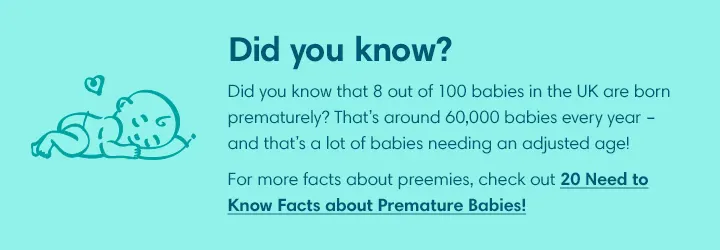Corrected Gestational Age
If you’re a parent of a baby born premature, you’ll probably want to know (and use) their corrected gestational age. Premature babies are born early, so they’ll need a little time to catch up! When tracking growth and development, it’s best to adjust age for prematurity. So, what is corrected or adjusted gestational age and what does it mean? Keep reading to learn all the details, including how to calculate your preemie baby’s corrected age.
What Does Corrected Gestational Age Mean?
Corrected gestational age or adjusting for prematurity simply means using a corrected age for your preterm baby. The age of a baby can be calculated in two ways. The first way is called the uncorrected age, which is the number of weeks or months that have passed since your baby was born. The second way is called the corrected age, which takes into account the time that has passed since your baby's original due date. This can help you and your child’s caregivers better understand where your premature baby is in their growth journey. Plus, it’s helpful as you learn how to care for your preemie baby at home.
Why Corrected Age Is Important
A premature baby's chronological age is inaccurate when tracking growth and development. For example, a baby born at 40 weeks may coo or smile at 1 month old, while a 30-week preemie may still be in the NICU, catching up on the growth and development they missed out on in the womb.
To track milestones, it's essential to use a neonatal age corrected for preterm birth. This adjusted birth date is used for growth and newborn development, and helps explain delayed milestones.
When to Use Corrected Age
Correcting age for prematurity is how healthcare professionals ensure that preemie development is progressing as it should. For example, a 6-month-old premature baby born two months early would have a corrected age of 4 months. Despite being in the world for six wonderful months, they wouldn’t be expected to reach the common developmental milestones of a 6-month-old baby. Instead, their family’s GP and health visitor will track their growth and progress as a 4-month-old. So, what does that mean for physical developments like gross motor skills or social developments like playing? Keep reading to understand how and when to use corrected gestational age for these developmental purposes.

Corrected Age: How it Influences Growth and Development
A preterm baby will typically reach development milestones a little later than a full-term baby. These may include:
Waving arms and legs
Turning their head when enjoying tummy time
Holding their head up
Standing and supporting their own weight
Taking steps with help
Picking up and putting down objects with one hand
Standing and taking steps independently.
Essentially, but not precisely, corrected gestational age starts at your baby’s original due date or around 37 to 40 weeks. So, they’ll still reach these important milestones, but at their adjusted age.
Corrected Age: How it Influences Play and Social Interaction
Preterms may reach language and social developments later than at-term babies, including:
Crying as communication
Laughing and squealing
Repeating sounds you make
Looking at an object when you refer to it and communicating by pointing
Smiling when they see you or when you talk to them
Smiling and cooing at themselves in a mirror
Recognising familiar faces
Following simple commands, like ‘come here’ or ‘put it down’
Showing affection to a doll or toy
Playing by rolling or tossing a toy back and forth with you.
Once again, there’s no need to fret – your preemie will reach these milestones at their corrected age.
How to Calculate Corrected Gestational Age
You’ve already read a few examples of corrected age, but here we break down the exact calculation so that you know how to accurately adjust for prematurity:
| Your baby’s chronological age (how long it’s been since they were born) – the number of days (or weeks) they were born early = adjusted age |
So, for example, let’s say your baby is 10 months old but they were born seven weeks prematurely. Here’s how you would then calculate your baby’s adjusted age:
| 10 months – 7 weeks = 8 months, 1 week |
FAQS AT A GLANCE
No, you wouldn’t use a corrected gestational age for a baby born at 37 weeks or later, as that’s not considered premature. But, if your little one was born anytime before 37 weeks, you should use a corrected age when addressing development and growth.
The Bottom Line
Premature babies need time to reach all those important developmental milestones that would’ve occurred while still in the womb. Therefore, their actual age (chronological age) won’t match the typical growth and development of a baby born full term. That’s why your GP and health visitor will use a corrected gestational age for your preemie when tracking their growth. How to calculate your baby’s corrected gestational age is simple in theory. Simply subtract the number of days, weeks or months from the time since their birth to calculate the corrected gestational age, or use our Corrected Age Calculator.
Friends and families of babies born prematurely can now order their Pampers Preemie Protection Nappies online for free home delivery via www.pampers.co.uk/preemies-ordering-platform. Pampers also continue to donate Pampers Preemie Protection nappies direct to hospitals, and via ASDA pharmacies (in-store only and subject to availability)
How We Wrote This Article The information in this article is based on the expert advice found in trusted medical and government sources, such as the National Health Service (NHS) and has been reviewed by Bliss. You can find a full list of sources used for this article below. The content on this page should not replace professional medical advice. Always consult medical professionals for full diagnosis and treatment.
Read more about Prematurity
Join Pampers Club and get:




